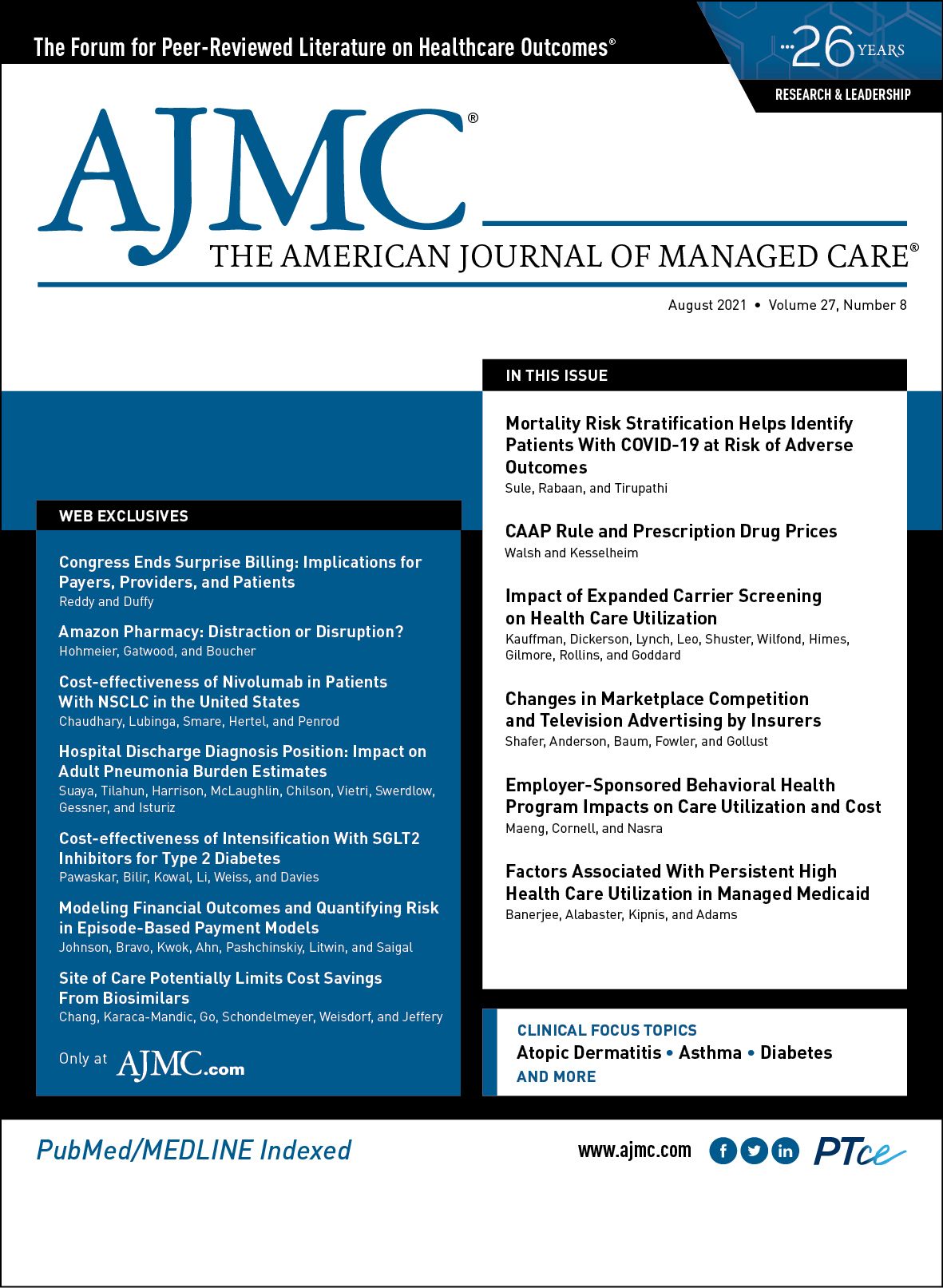Publication
Article
The American Journal of Managed Care
Mortality Risk Stratification Helps Identify Patients With COVID-19 at Risk of Adverse Outcomes
Author(s):
Mortality risk stratification can identify patients with COVID-19 who are at higher risk of mortality, discharge to skilled nursing facility, and readmission, and may benefit from focused intervention strategies.
Am J Manag Care. 2021;27(8):309-310. https://doi.org/10.37765/ajmc.2021.88721
Takeaway Points
- This study identifies a risk stratification tool that can help categorize hospitalized patients with COVID-19 into those at a higher risk of death, discharge to skilled nursing facility, or readmission, and those who are at low risk.
- Patients at high risk should be monitored closely, with a greater allocation of resources for care during hospitalization and the postdischarge period.
- The low-risk group of patients should be targeted for length-of-stay reduction strategies.
We are writing a follow-up to our original research article, “Mortality Risk Stratification Can Predict Readmissions but Not Length of Stay.”1 Since March 2020, COVID-19 has been overwhelming health care systems around the world. We wanted to test whether our mortality risk stratification (MORIS) system1-3 can stratify patients who are at risk of having various adverse outcomes.
The data for all adult patients discharged from 1 of 7 Trinity Health Michigan hospitals with a diagnosis of COVID-19 in 2020 were extracted as a report from the Epic electronic health record system (without identifying any patients) after obtaining institutional review board approval. The data were analyzed as described in our original manuscript.1 All encounters, including readmissions, were considered in the data as separate unique events, as the MORIS strata are dynamic and may change from one encounter to the next encounter based on the patient’s clinical presentation. The last day of discharge for the 30-day readmission analysis was November 30, 2020; for the 90-day readmission analysis, it was September 30, 2020.
There is a significant association between MORIS strata and in-hospital mortality (χ2: P < .0005). All other outcomes are in patients who were discharged alive (Table). Although there is a significant association between MORIS strata and admission to the intensive care unit (χ2: P < .0005), there is no association between MORIS strata and the length of stay in the intensive care unit (analysis of variance [ANOVA]: P = .167). The hospital length of stay is associated with the MORIS strata (ANOVA: P < .0005), and for all possible pairs of MORIS strata, the hospital length of stay varies significantly (Bonferroni post hoc t tests: P < .0005), except for stratum 1 vs stratum 2 (Bonferroni post hoc t test: P = .083) and stratum 4 vs stratum 5 (Bonferroni post hoc t test: P = .637). A significant association is seen between MORIS strata and discharge to a skilled nursing facility (χ2: P < .0005), 30-day readmission (χ2: P < .0005), and 90-day readmission (χ2: P < .0005).
We believe that this stratification system would allow hospitals to allocate resources in an evidence-based manner to decrease the potential for burnout in clinicians. Patients with COVID-19 in strata 1 and 2 should be closely monitored and aggressively treated because they are at the highest risk of in-hospital mortality. These patients should be mobilized and treated with physical therapy earlier. They are likely to require postdischarge placement at a skilled nursing facility. All these patients should receive care management, social work, and transitional care management interventions to prevent readmissions. Bundles of care interventions specific to patients’ diagnoses (eg, COVID-19, congestive heart failure, acute myocardial infarction, chronic obstructive pulmonary disease) should be developed and used in a risk-stratified patient population to provide the highest value for the resources allocated.
Acknowledgments
The authors thank Timothy Wildauer for data extraction and Karen Hagglund, MS, for statistical analysis.
Author Affiliations: St Joseph Mercy Oakland (AAS), Pontiac, MI; Molecular Diagnostic Laboratory, Johns Hopkins Aramco Healthcare (AAR), Dhahran, Saudi Arabia; Wellspan Chambersburg and Waynesboro Hospitals (RT), Chambersburg, PA; Penn State College of Medicine (RT), Hershey, PA.
Source of Funding: None.
Author Disclosures: The authors report no relationship or financial interest with any entity that would pose a conflict of interest with the subject matter of this article.
Authorship Information: Concept and design (AAS); acquisition of data (AAS); analysis and interpretation of data (AAS); drafting of the manuscript (AAS, AAR, RT); critical revision of the manuscript for important intellectual content (AAS, AAR, RT); statistical analysis (AAS); provision of patients or study materials (AAS); administrative, technical, or logistic support (AAR, RT); and supervision (AAS, AAR, RT).
Address Correspondence to: Anupam Ashutosh Sule, MD, PhD, St Joseph Mercy Oakland, Administration Ste, 44405 Woodward Ave, Pontiac, MI 48341. Email: Anupam.a.sule@stjoeshealth.org.
REFERENCES
1. Sule AA, Dada RS, Dada J. Mortality risk stratification can predict readmissions but not length of stay. Am J Manag Care. 2021;27(2):66-71. doi:10.37765/ajmc.2021.88584
2. Cowen ME, Strawderman RL, Czerwinski JL, Smith MJ, Halasyamani LK. Mortality predictions on admission as a context for organizing care activities. J Hosp Med. 2013;8(5):229-235. doi:10.1002/jhm.1998
3. Cowen ME, Czerwinski JL, Posa PJ, et al. Implementation of a mortality prediction rule for real-time decision making: feasibility and validity. J Hosp Med. 2014;9(11):720-726. doi:10.1002/jhm.2250







